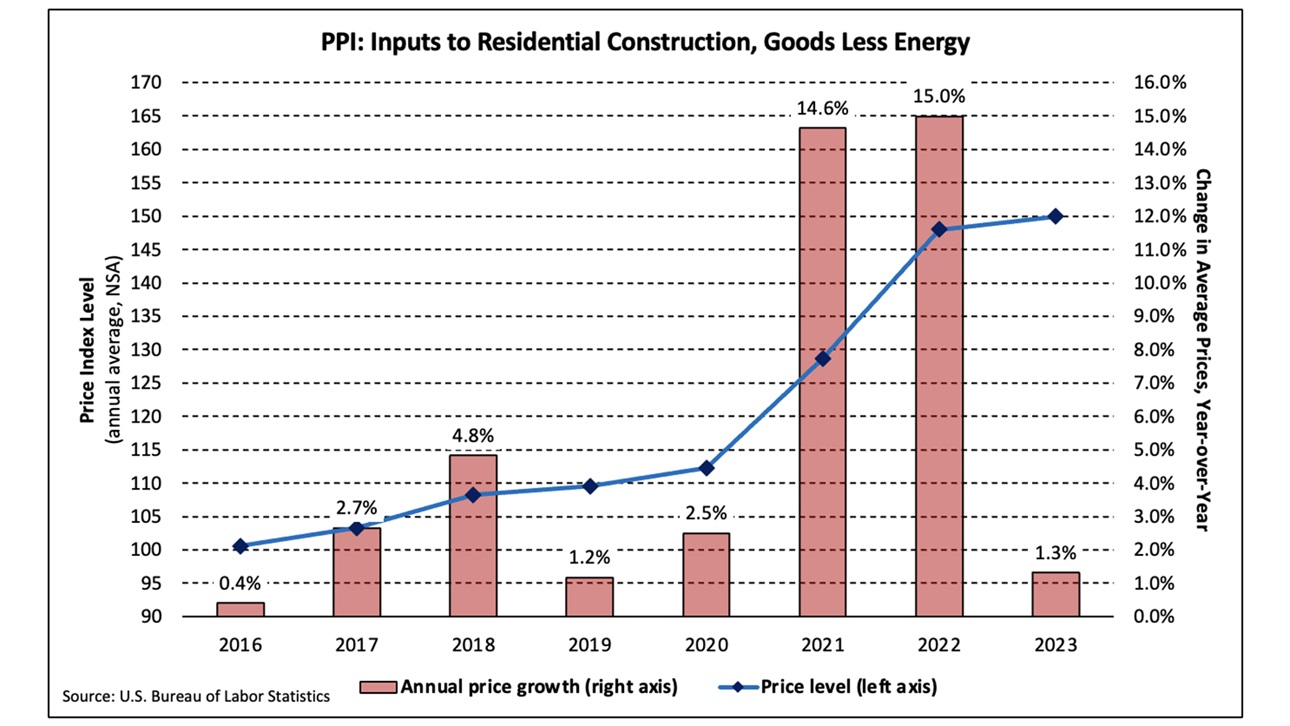How Soaring Prices for Building Materials Impact Housing
Prices of materials used in residential construction have been flat or even declined in some cases, providing welcome relief to home builders. But overall, prices of building materials are still far above their pre-pandemic levels, and the impact of those elevated prices can be seen in unexpected places.
Where are Building Material Prices Now?
Earlier this year, NAHB reported that building material price growth slowed dramatically in 2023, in line with slowing inflation in the broader economy. Prices still grew, though, and were still elevated from post-pandemic surges.

“The only major building material to see price recovery is lumber,” said Jesse Wade, NAHB director of tax and trade policy analysis. “At the end of 2023, lumber was trading about 20% higher than in 2019, but with further price declines in 2024, the price is roughly back to normal. This is after surges in 2020-21 that saw lumber prices rise more than 300%.”
For other build materials categories, prices are still far above their pre-pandemic levels.
Gypsum (drywall): Prices decreased 2% over 2023, after increasing 44.6% over the two years ending December 2022.
Ready-mix concrete: The average price of concrete increased 11.2% in 2023 and 10.3% in 2022, combining for the second-largest two-year increase since 2000.
Steel mill products: Steel mill products annual average prices declined 16.1% in 2023 after increasing 8.7% in 2022 and the historic 90.3% increase of 2021. Prices are 31.2% lower than their 2021 peak but remain 65.1% higher than they were in January 2020.
Why Did Building Material Prices Rise So High?
It’s easy to blame the pandemic for all our woes, and it certainly didn’t help building material prices. But material prices were pointed higher long before the first mention of COVID.
Beginning in late 2017 and continuing for most of 2018, building material prices grew more than 5%, mostly driven by trade disputes for materials sourced overseas.
“In the spring of 2020, supply and demand forces took over the lumber market,” said Wade, who continually tracks and analyzes short- and long-term trends in commodities pricing. “Home builders got back to work very quickly, and people stuck at home decided to invest in home repairs, renovations and upgrades. So lumber prices soared. But it wasn’t until early 2021 that other material prices began to rise.”
What Causes the Rise in Material Prices?
Supply and demand: Although lumber was the most sensitive material to demand, other materials quickly followed, and for good reason. There were more homes started in 2020 than in 2019, even with all the lockdowns. The number of homes started in 2021 was a 15-year high. In short, there was high demand for materials in 2020 and 2021.
Broader inflation: When the general cost of goods and services rises across the economy, it inevitably impacts the price of construction materials.
Global factors: Factors such as geopolitical tensions, trade disputes and changes in international trade policies can disrupt supply chains and lead to price instability.
Sustainability initiatives: There's a growing demand for eco-friendly, sustainable building materials and green practices in the construction industry. Although this is a positive trend for the environment, it can put pressure on costs as these specialty materials often come with a higher price tag.
How Do High Material Costs Impact Housing?
Aside from simply making it more expensive to build — and thus, buy — a home, rising material prices can have insidious effects on the housing market.
Home insurance premiums have soared over the past year. One of the primary drivers of the rate increases is the cost of building materials used to repair homes after claims. Although building material prices have been growing for years, we are just starting to see the impact on the insurance market.
Material cost fluctuations also make it more difficult for appraisals to reflect the true value of the home, because costs are rising too rapidly and builders are having to compensate on the front end of construction by decreasing amenities available in the home. Inaccurate valuations can cause major issues in financing for home buyers.
At a time when mortgage rates and home prices are at multi-decade highs, the rising insurance premiums and uneven valuation environment makes housing attainability much harder.
Latest from NAHBNow
Dec 29, 2025
Last Chance to Complete the 2025 Census SurveyMembers will receive a final reminder this week from NAHB to complete our 2025 Builder and Associate Member Census. We encourage you to fill this survey out by Dec. 31, 2025, to help us better understand the composition and characteristics of the members who belong to our Federation.
Dec 26, 2025
New Hampshire HBA Provides Free Home Renovations for Local VeteransWith the mission of giving back and ensuring veterans across the state have a better quality of life, the New Hampshire Home Builders Association (NHHBA) created the Builders Care NH Foundation, a 501(c)(3) organization dedicated to helping those in need.
Latest Economic News
Dec 22, 2025
State-Level Employment Situation: September 2025In September 2025, nonfarm payroll employment was largely unchanged across states on a monthly basis, with a limited number of states seeing statistically significant increases or decreases. This reflects generally stable job counts across states despite broader labor market fluctuations. The data were impacted by collection delays due to the federal government shutdown.
Dec 19, 2025
Existing Home Sales Edge Higher in NovemberExisting home sales rose for the third consecutive month in November as lower mortgage rates continued to boost home sales, according to the National Association of Realtors (NAR). However, the increase remained modest as mortgage rates still stayed above 6% while down from recent highs. The weakening job market also weighed on buyer activity.
Dec 18, 2025
Lumber Capacity Lower Midway Through 2025Sawmill production has remained essentially flat over the past two years, according to the Federal Reserve G.17 Industrial Production report. This most recent data release contained an annual revision, which resulted in higher estimates for both production and capacity in U.S. sawmills.
